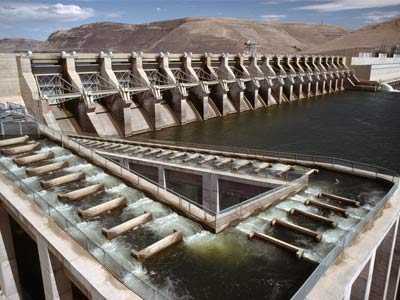Since they greatly alter the landscape and ecology of a river, dams have a huge effect on the fish that depend on those rivers for their habitat. This is especially true for migratory fish, such as the well-known salmon, whose life cycles depend on moving up and down the river without obstructions. These fish are born upstream in the river, travel to the ocean to mature, and then travel back up the river to spawn, normally following instinct and returning to where they were hatched.
Dams wipe out migratory fish populations in massive numbers by blocking and destroying spawning habitat. For fish traveling back up river to spawn, the dam's construction must provide a way for the fish to get over the dam, either through a bypass waterway route looping around the dam, or fish ladders built into the dam. Problems still persist on the other side of the dam though, with the large unnatural reservoir that the dam creates. Depending on the time of year and river flow, the reservoirs will either be fairly low and the appropriate spawning habitat for the fish, or they can be very high and submerge entire spawning sites, creating an unstable spawning site for the fish to depend on coming back to.

Fish ladders that fish jump to bypass a dam in their migrations.
For those fish that are able to make it upriver and spawn successfully, their juvenile fish traveling back down the river will encounter problems as they enter the dam created reservoir. As freshwater river fish, the fish need to be in water of a certain temperature that normally is present when the river flows as it naturally would. With the reservoir, the top surface waters that stagnantly sit becoming warm from the sun, are often too warm for the fish to survive in, so they then travel to the lower and colder waters of the reservoir, but these waters are so low they do not contain enough dissolved oxygen for the fish to survive.
The dent dams put in fish populations have repercussions all the way up the food chain to top predators, such as the Yangtze River Dolphin. Already critically endangered in 2006 when the Three Gorges Dam was constructed, this rare and historically sacred mammal was reported functionally extinct in 2007, with the dam serving as one of the main tipping points for its extinction. The dolphin was already competing with the large fishing industry for its prey, and the drop in prey population numbers following the dam's activation made the struggle for food one their dwindling population could not meet. In addition, the dam hurt the dolphin's main hunting technique, with its loud rushing waters that throw off the nearly blind dolphin's sonar abilities.